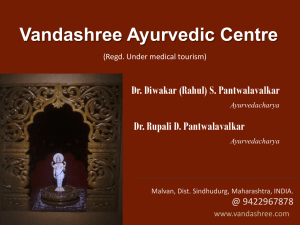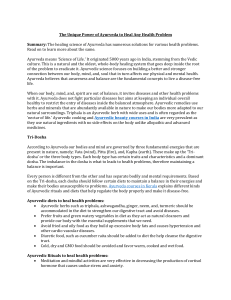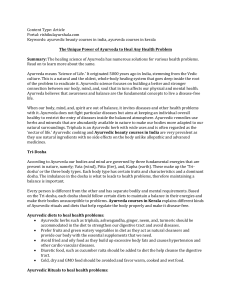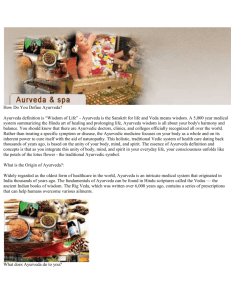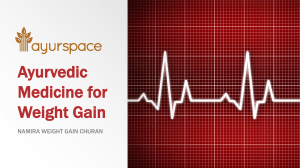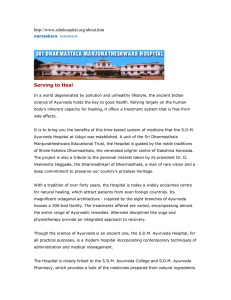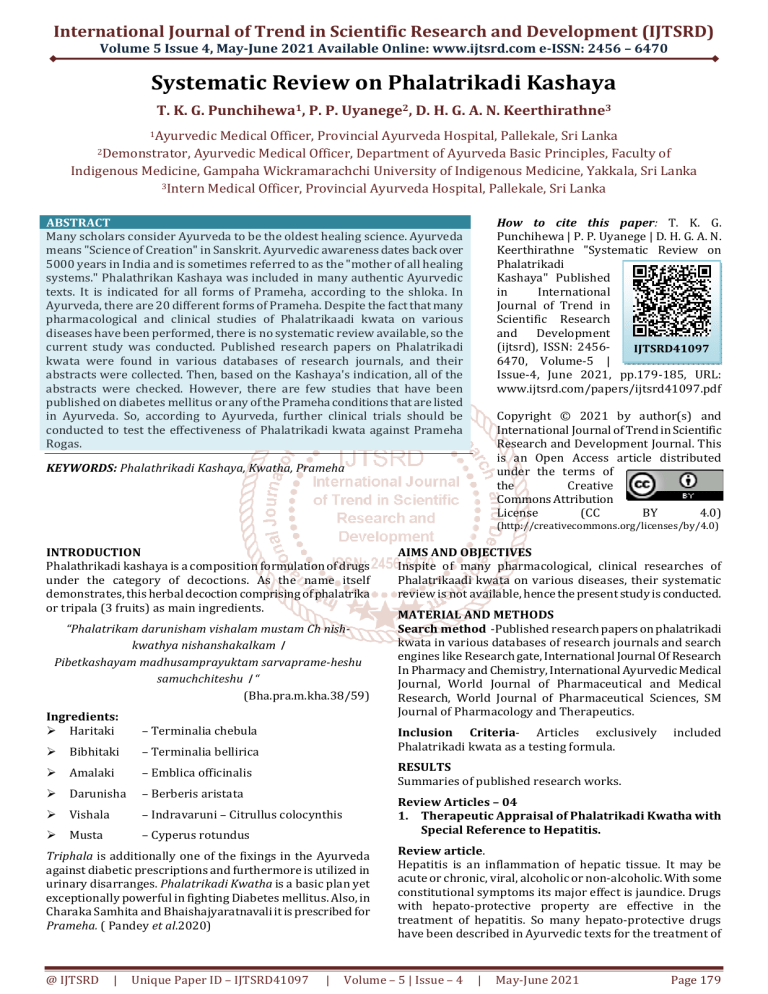
International Journal of Trend in Scientific Research and Development (IJTSRD) Volume 5 Issue 4, May-June 2021 Available Online: www.ijtsrd.com e-ISSN: 2456 – 6470 Systematic Review on Phalatrikadi Kashaya T. K. G. Punchihewa1, P. P. Uyanege2, D. H. G. A. N. Keerthirathne3 1Ayurvedic Medical Officer, Provincial Ayurveda Hospital, Pallekale, Sri Lanka Ayurvedic Medical Officer, Department of Ayurveda Basic Principles, Faculty of Indigenous Medicine, Gampaha Wickramarachchi University of Indigenous Medicine, Yakkala, Sri Lanka 3Intern Medical Officer, Provincial Ayurveda Hospital, Pallekale, Sri Lanka 2Demonstrator, How to cite this paper: T. K. G. Punchihewa | P. P. Uyanege | D. H. G. A. N. Keerthirathne "Systematic Review on Phalatrikadi Kashaya" Published in International Journal of Trend in Scientific Research and Development (ijtsrd), ISSN: 2456IJTSRD41097 6470, Volume-5 | Issue-4, June 2021, pp.179-185, URL: www.ijtsrd.com/papers/ijtsrd41097.pdf ABSTRACT Many scholars consider Ayurveda to be the oldest healing science. Ayurveda means "Science of Creation" in Sanskrit. Ayurvedic awareness dates back over 5000 years in India and is sometimes referred to as the "mother of all healing systems." Phalathrikan Kashaya was included in many authentic Ayurvedic texts. It is indicated for all forms of Prameha, according to the shloka. In Ayurveda, there are 20 different forms of Prameha. Despite the fact that many pharmacological and clinical studies of Phalatrikaadi kwata on various diseases have been performed, there is no systematic review available, so the current study was conducted. Published research papers on Phalatrikadi kwata were found in various databases of research journals, and their abstracts were collected. Then, based on the Kashaya's indication, all of the abstracts were checked. However, there are few studies that have been published on diabetes mellitus or any of the Prameha conditions that are listed in Ayurveda. So, according to Ayurveda, further clinical trials should be conducted to test the effectiveness of Phalatrikadi kwata against Prameha Rogas. Copyright © 2021 by author(s) and International Journal of Trend in Scientific Research and Development Journal. This is an Open Access article distributed under the terms of the Creative Commons Attribution License (CC BY 4.0) KEYWORDS: Phalathrikadi Kashaya, Kwatha, Prameha (http://creativecommons.org/licenses/by/4.0) INTRODUCTION Phalathrikadi kashaya is a composition formulation of drugs under the category of decoctions. As the name itself demonstrates, this herbal decoction comprising of phalatrika or tripala (3 fruits) as main ingredients. “Phalatrikam darunisham vishalam mustam Ch nishkwathya nishanshakalkam । Pibetkashayam madhusamprayuktam sarvaprame-heshu samuchchiteshu । “ (Bha.pra.m.kha.38/59) Ingredients: Haritaki – Terminalia chebula Bibhitaki – Terminalia bellirica Amalaki – Emblica officinalis Darunisha – Berberis aristata Vishala – Indravaruni – Citrullus colocynthis Musta – Cyperus rotundus | Unique Paper ID – IJTSRD41097 MATERIAL AND METHODS Search method -Published research papers on phalatrikadi kwata in various databases of research journals and search engines like Research gate, International Journal Of Research In Pharmacy and Chemistry, International Ayurvedic Medical Journal, World Journal of Pharmaceutical and Medical Research, World Journal of Pharmaceutical Sciences, SM Journal of Pharmacology and Therapeutics. Inclusion Criteria- Articles exclusively Phalatrikadi kwata as a testing formula. included RESULTS Summaries of published research works. Review Articles – 04 1. Therapeutic Appraisal of Phalatrikadi Kwatha with Special Reference to Hepatitis. Triphala is additionally one of the fixings in the Ayurveda against diabetic prescriptions and furthermore is utilized in urinary disarranges. Phalatrikadi Kwatha is a basic plan yet exceptionally powerful in fighting Diabetes mellitus. Also, in Charaka Samhita and Bhaishajyaratnavali it is prescribed for Prameha. ( Pandey et al.2020) @ IJTSRD AIMS AND OBJECTIVES Inspite of many pharmacological, clinical researches of Phalatrikaadi kwata on various diseases, their systematic review is not available, hence the present study is conducted. | Review article. Hepatitis is an inflammation of hepatic tissue. It may be acute or chronic, viral, alcoholic or non-alcoholic. With some constitutional symptoms its major effect is jaundice. Drugs with hepato-protective property are effective in the treatment of hepatitis. So many hepato-protective drugs have been described in Ayurvedic texts for the treatment of Volume – 5 | Issue – 4 | May-June 2021 Page 179 International Journal of Trend in Scientific Research and Development (IJTSRD) @ www.ijtsrd.com eISSN: 2456-6470 liver diseases with reference to kamala. Clinically kamala is correlated with jaundice. ‘Phalatrikadi kwatha’- decoction of eight ingredients has been described by Chakrapanidutta for the treatment of kamala in his book on medicineChakradutta. Its ingredients have cholagogue, cholerectic and anti-oxidant property. It strengthens liver tissue. Kwatha is prepared by boiling crude drugs in water in ratio of 1:16 and reducing to one eighth of original quantity. Ayurveda has very rich treasure of herbal medicine and formulations and Phalathrikadi kwatha is one of them. It is now a proven hepato-protective agent having antioxidant, cholerectic, cholagogue activity and membrane stabilizing effect as well as anti- viral property. So it can be used in any type of hepatitis. 2. A Critical Review of Phaltrikadi kwath WSR to Liver Disorders. Phalatrikadi kwath, this formulation had been mentioned in the context of Pandu and Kamala in Chakradatta (8/8), Sharangdhar Samhita (2/75), Yoga Ratnakar (5th sloka) pandu roga and Bhaisajya Ratnavali (12/22). Phalatrikadi Kwath contains eight drugs which arepredominatly useful in the treatment of koshthashrit kamala / Hepatocellular jaundice, Cirrhosis, Alcoholic hepatitis, Fatty liver and more likewise condition of liver. First described in Chakradutta written by Chakrapanidutta in 11th century and later on many texts, is the most popular and effective preparation contains the eight herbs namely Haritaki, Vibhitaki, Amalki, Amrita, Katuki, Nimba, Kirattika and Vasa. In the present review study I had tried to understand and explain the properties, mode of action on dosha (physiological entities of human body), mechanism of action on modern medicine parameters and research works conducted in different universities. The description of each herbs explained on all the above parameters. One should avoid over medication and Pseudo medication while treating a patient of liver disorders. Different awareness programme should be performed about avoiding self medications by the patients of liver diseases. Patient in the management of these patients herbal preparations are very much effective. Ayurvedic herbal preparations have many advantages like shortening of disease period,early regeneration of liver parenchymal cells, avoid post hepatitis residual symptoms and avoid complications such as Cirrhosis, Hepatocellular Carcinoma and Hepatic Encephalopathy. So many research works had been conducted all over the country on different diseases and parameters,as described above . However further work can be continued on different parameters. 3. Phalatrikadi Kvatha An Ayurvedic Hepatoprotective Drug. Phalatrikadi kvatha is one of the important prestigious formulations, which is successfully used from the ancient period. This formulation has been mentioned in the context of Pandu and Kamala, in Cakradatta, Yoga Ratanakara, Sharangadhara Samhita and Vrinda Madhava but first time described in Siddhasara samhita, as the name of Phalatrika. Phalatrikadi kvatha contains eight drugs which are having predominately Hepato -protective properties. on the basis of above dimensions, we can say that all the drugs, which are mentioned a base is having hepetoprotective effects. The above mentioned drugs have the following Ayurvedic properties; Pitta hara, Pitta Rechana, Yakruduttejaka, Dipana, Rechana, Shothahara, Jvarahara, @ IJTSRD | Unique Paper ID – IJTSRD41097 | Kamala-hara, Pandu-hara, Kapha pitta Thridoshahara, Rasayana, Kshayaghna . shamaka, 4. Impact of Particle Size of Kwathya Dravya (decoction powder) in the Preparation of Phalathrikadi Kwath The study was aimed to investigate the effects of particle size, vessel used, and extraction time in the preparation of Phalathrikadi kwath. The particle size of Kwath dravya (solute) was cut into the size of 0.5 cm, 1 cm, 1.5 cm, 2 cm, and coarse powder (pass 60#). The ratios of solvent (water) were 16 times of solute and boiling was done till 1/4th part of the solvent was remain. The provided extraction time was also varied 5.5 to 6h at temperature range 23°C–90°C. Phaltrikadi kwath was prepared as per formula mentioned in “Sharngadhar samhita” Madhyam khand 2/77. 15 samples of Phaltrikadi kwath were prepared and analyzed for physicochemical and phytochemical parameters, from obtained value, it was confirmed that extraction procedure with varied particle size significantly affected the yield of active pharmaceutical ingredients in prepared Phaltrikadi kwath. Coarse particle sizes can produce a higher yield. Moreover, a longer extraction time produces a higher yield. Kwath (decoction) prepared by particle size 1.5 cm and 2.0 cm may be more therapeutically effective, as it has total solid content more than 6%, it proves that “Yavakuta” phenomena of Ayurvedic classics. Case studies – 04 1. Potent Hepatoprotective Phalatrikadi Kwath: A Clinical Study The main object of the study is to clinically evaluate the efficacy of an Ayurvedic compound formulation Phalatrikadi Kvatha (PTK) on Hepatitis B patients. Total 59 Hepatitis B positive patients were selected from OPD and IPD of S.S. Hospital, Institute of Medical Sciences, B.H.U. PTK was given in a dose of 80 ml/day in two divided doses for 6 months and follow up was done on every third month. In each follow up Routine Hematological examinations- Hb%, TLC, DLC and ESR; Biochemical investigations- LFT, Serological test- HBsAg (for HBV) and HBV DNA and Radiological tests- USG whole abdomen were done. Result showed significant effect of Phalatrikadi Kvatha (PTK) on sign and symptoms of Hepatitis which was evidenced by laboratory investigations i.e. LFT (p<0.05), negative HBsAg in 8 patients and HBV DNA (Chi-square =45.9 and P<0.01).Thus present results showed efficacy of PTK on Hepatitis. Present findings suggest that Phalatrikadi Kvatha (PTK) is an effective and beneficial formulation for management of Hepatitis B patients. 2. Ayurvedic Management of Diabetes Mellitus - A Single Case Study. The study was intended to have a theoretical audit of the Madhumeha and its treatment specifically to the utilization of a natural drug Phalatrikadi kwatha. Madhumeha, otherwise called Diabetes Mellitus is one of the sorts of Vatajaprameha, that has been considered as an incurable illness (Mahagada). Because of extravagance in etiological components it brings about the inadequate arrangement of Kapha and Meda which further continues descending through the channels of Mutravaha srotas and get confined at Basti mukha prompting the side effects like Prabhoota mutrata (polyuria), Avila mutrata (tubidity of pee) and so on. As the disease is Chirakari, it requires a compelling treatment which can be proceeded for quite a while with no Volume – 5 | Issue – 4 | May-June 2021 Page 180 International Journal of Trend in Scientific Research and Development (IJTSRD) @ www.ijtsrd.com eISSN: 2456-6470 evil impacts. Among the numerous treatment measures referenced, Phalatrikadi kwath has been chosen in this examination and the impact was assessed. In the current logical examination a 53 years old Male directed in Outpatient having Objections of the patient was increased thirst, frequent urination, hunger, fatigue and blurred vision. By taking a gander at the signs and appearances of complaints of patient was resolved to have Diabetes after exhortation glucose tests reports. In the current case report lenient was required to treat with ayurvedic plan under the treatment of Diabetes. Going to the OPD of YMT Ayurvedic Hospital Kharghar and treated with preliminary medication (Phalatrikadi kwatha). Patients were assessed in a time period for 15 days. FBS, PPBS with clinical sign and manifestations were tested.In the wake of assessing the absolute impacts of the treatment, it was seen that Phalatrikadi kwath alongside diet and routine gave good alleviation. Significant result was observed with this treatment protocol in the management of Madhumeha. 3. A Clinical Study to Evaluate and Compare the Efficacy of Kamalahara Kashaya and Phalatrikadi Kashaya in Koshtashakhasrita Kamala. Rakta Dhatu is given utmost importance as the disease incidences pertaining to Rakta are more in number. Kamala is such a disease where in the Rakta Dhatu is vitiated primarily by Pitta Dosha. The clinical presentation of Koshtashakhasrita Kamalastands in parlance with Hepatic Jaundice, especially Infective Hepatitis stands in parlance with Hepatic Jaundice. Kamala being a Pitta Pradhana Vyadhi should be treated with Pitta Rechaka & Shamaka Aushadhiamaka Aushadhi, Most of the Dravya in Kamalahara Kashaya and Phalatrikadi Kashaya have Tridoshahara property and almost all drugs have Pittahara property. Hence a sincere effort is made to evaluate and compare the effect of Kamalahara Kashaya and Phalatrikadi Kashaya in Koshtashakhasrita Kamala.. The study was a Single Blind Randomized Parallel Comparison Clinical Study.The study was conducted in 40 subjects for a period of 28 days.Clinical features and hematological parameters were documented atbaseline, 7th day, 14th day and after treatment. Observations were analyzed and findings were evaluated by using statistical methods.This study shows that both Kamalahara Kashaya and Phalatrikadi Kashaya have significant effect in Koshtashakhasrita Kamala.The result obtained was both Kamalahara Kashaya and Phalatrikadi Kashaya have significant effect in Koshtashakhasrita Kamala . There is no significant difference in the effect of Kamalahara Kashaya and Phalatri- kadi Kashaya in Koshtashakhasrita Kamala. 4. Management of Hepatitis B (Carrier stage) Through Ayurveda Hepatitis B is a potentially life-threatening liver infection caused by the hepatitis B virus (HBV). It is a major global health problem. On the basis of clinical features, Hepatitis B can be correlated with Kamala. Kamala is caused due to aggravation of Pittadosha. Ayurvedic management of Kamala includes samshodhan and samshaman therapy which leads to break the samprapti of the disease and hence provides complete cure. In this case study 53 years old male patient having complaints of yellowish colored urine and reduced appetite along with generalized weakness, nausea and mild pain in right hypochondriac region was treated with herbomineral preparations (Phalatrikadi Kwath, Arogyavardhini Vati, Liv52 HB, Rohitakarishta etc.) @ IJTSRD | Unique Paper ID – IJTSRD41097 | described in classical texts of Ayurveda for 6 months. Assessment was done on the Subjective & Objective (Pathological) Parameters Before, after and during treatment. Significant improvement was observed in subjective and objective parameters after completion of treatment. From this study it can be concluded that Hepatitis B can be successfully managed with principles of Ayurveda. Comparative Studies - 07 1. A Comparative Placebo, Control Clinical Evaluation of Phalatrikadi Kwath inMadhumeha with Special Reference to Diabetes Mellitus Type2. The study was aimed to have a conceptual review of the disease Madhumeha and its treatment in particular to the use of an herbal drugs Phalatrikadi Kwatha and to compare its efficacy with the control drug (metformin) and placebo through scientific parameters in a double blind clinical control trial. Madhumeha, also known as Diabetes Mellitus is one of the types of Vataja prameha, that has been considered as an incurable disease (Mahagada). Due to indulgence in etiological factors it results in the incomplete formation of Kapha and Meda which further proceeds downward through the channels of Mutravaha srotas and get localized at Basti mukha leading to the symptoms like Prabhoota mutrata (polyurea), Avila mutrata (tubidity of urine) etc. As the disease is Chirakari, it requires an effective treatment which can be continued for a long time without any ill effects. Among the many treatment measures mentioned, Phalatrikadi kwath has been selected in this study and the effect was evaluated. The clinical study includes 50 patients of either sex between 30-60 years of age with Madhumeha (Type2 Diabetes Mellitus) were recruited having range of blood sugar (fasting 126-180 mg/dl, postprandial sugar, 200-250 mg/dl) attending the OPD of G.A.M Puri, Odisha and were divided into three groups. Group I (30 patients) were treated with trial drug (Phalatrikadi kwatha), Group II (10 patients) were treated with control drug (Metformin) and Group III (10 patients) were treated with placebo. All the three groups were recommended with uniform classically described diet (Ahara) & regimen (Vihara). Patients were evaluated in an interval of 15 days for one month. FBS, PPBS with clinical sign & symptoms were assayed. After evaluating the total effects of the treatment, it was observed that Phalatrikadi kwath along with diet and regimen gave satisfactory relief in comparison to control drug (metformin) which is an established drug. 2. A Comparative Clinical Study On Phalatrikadi Kwata and Darvyadi Kwatha in the Management of Kamala W.S.R. to Jaundice. Jaundice (Kamala) is a yellowish pigmentation of the skin, the conjunctival membranes over the sclera (whitish of the eyes), and other mucous membranes caused by hyperbilirubinemia (increased levels of bilirubin in the blood). Today lifestyle with unhygienic and poor dietary habits and alcoholic habits etc. are responsible factors to promote hepatic damage which clinically reflects as Kamala Roga. The incidence of such causes resulting in Jaundice. In India it is 2.37-3.15 per 1000 population. The effect of Ayurvedic treatment was assessed in relation to improvement in overall clinical signs and symptoms. Objectives of this study is to evaluate the effect of Phalatrikaadi Kwatha and Darvyadi Kwatha in Kamala Roga. A comparative clinical Volume – 5 | Issue – 4 | May-June 2021 Page 181 International Journal of Trend in Scientific Research and Development (IJTSRD) @ www.ijtsrd.com eISSN: 2456-6470 study was conducted on Kamala for period of 15 days. The patients were divided into 2 groups. In Group A 20 patients were administered with Phalatrikadi Kwatha internally and in Group B 20 patients were administered with Darvyadi Kwatha internally. Group A and Group B have shown statistically significant result. Group B treated with Darvyadi Kwatha showed better result compared with Group A treated with Phalatrikadi Kwatha. 3. A Comparative Study of Hansa Mandura & Phalatrikadi Kwatha in the Management of Pandu W.S.R. to Iron Deficiency Anaemia. Pandu is a disease characterized by pallor of body which strikingly resembles with 'Anemia' of modern science. Rakta has been considered as a key factor for the Jeevana, Varna Prasada, Ayu and Mamsa Pushti of the body. Many a times it is seen that Rakta gets vitiated by Doshas, mainly by Pitta dosha as Rakta is Pittavargiya and disease like Pandu appear. In Ayurveda, Pandu is considered as a specific disease with its own pathogenesis and treatment.Thus an attempt has been made to study the disease Pandu Roga according to Ayurvedic text in the parlance of Iron Deficiency Anemia. The commonest type of Anemia that is met with in practice is Iron Deficiency Anemia. Iron Deficiency Anemia has potential consequences i. e. IDA reduces the work capacity of individual and entire population and brings serious economic consequences and obstacles to national development. It is the only nutrient deficiency which is also significantly prevalent in virtually all industrialized nations. Children, Adult Male and Females suffer the most form of this malady. Large number of these patients could be easily and cheaply treated with single oral iron preparation those are also available in Ayurvedic Classical book. In modern medicine, there is good treatment for Anemia with considerable result but that is only for acute deficiencies Anemias. No significant therapy is there for chronic Anemia which occurs due to metabolic defects. Ayurveda can provide better management in this area. Total 40 patients were registered in the study and were randomly divided in to two groups. In Group A (HM), 2 tab. of Hansa Mandura was given BD with Anupana of Takra and in Group B (PTK) 40 ml of Phalatrikadi Kwatha with Madhu was given twice a day on empty Stomach. The effects of therapy in both groups were assessed by a specially prepared proforma. The result obtained proved that, Group A (HM) showed better results than Group B (PTK). In Group A, 40% patients were completely cured and 60% were found with Marked Improvement, while in Group B only 7.14% patients got Complete Remission and Marked Improvement was observed in 35.71% patients. 4. Effect of Nisthushayadi Kwatha and Phalatrikadi Kwatha in Amlapitha– A Randomised Comparative Clinical Study. Amlapitta may be a clinical entity manifesting within the Annavaha Srotas. Kashyapa and Madhava have described this disease thoroughly. Amlapitta has become quite common because of the change within the food and life styles, sophistication and a stressful life. It is characterized by Avipaka, Klama, Tiktodhgara, Amlodhgara, Gaurava, Hritkanthadaha and Aruchi indicating the Vikruthi of Pachakapitta, Kledakakapha and Samanavata. The etiological factors and therefore the symptomatology manifested relate Amlapitta to diseases mentioned under Acid Peptic Disorders. Nistushayadi Kwatha and Phalatrikadi kwatha were selected. The main objectives of this study are to study @ IJTSRD | Unique Paper ID – IJTSRD41097 | and compare the effect of Nistushayadi Kwatha and effect of Phalatrikadi kwatha in the management of Amlapitta. A total number of 40 patients who fulfilled the inclusion criteria were selected, and randomly assigned into two groups i.e., Group A and Group B, comprising of 20 patients each. Group A and Group B were administered Nistushayadi kwatha andPhalatrikadi Kwatha respectively for 30days. Both the groups were advised Pathya Ahara. They were followed up after every 10th days. After the intervention the Samanya Lakshana of Amlapitta were observed, recorded and assessed. The overall assessment of both the groups, where group A receives Nistushyadi kwatha and group B Phalatrikadi kwatha shows promising improvement in the subjective parameters. Assessment was done using unpaired ‘t’ test between these two groups, the result was not quite statistically significant which means there is no much difference in the efficacy of these two formulation in the management of Amlapitta. Both the formulations shown nearly same outcome in the improvement of disease parameter. The reduction in the symptoms were started to be noticed by 7th day where the patients had reduction in Hrutkantha Daha, Aruchi, Kanthadaha and Angagourav. These symptoms resolved by 30th day. 5. A randomized Double Blind Comparative Clinical Study on Phalatrikadi Kwatha & Vidanga Rajanyadi Kwatha in Madhumeha (Diabetes Mellitus Type II ) The Objectives of this study are to evaluate the therapeutic effect of Phalatrikadikwatha and Vidanga Rajanyadikwatha in Madhumeha respectivelyand Comparing the therapeutic effect of Phalatrikadikadi kwatha and Vidanga Rajanyadi kwatha in patients suffering from Madhumeha. Study design type is a randomized double blind comparative clinical study. 30 patients of Madhumeha /Diabetes Mellitus having symptoms of Madhumeha (polyuria, polydypsia, and unexplained weight loss) with casual plasma glucose concentration ≥200 mg/dl or fasting plasma glucose ≥126 mg/dl were randomly categorized into two groups. Interventions: In (Group A) - Selected patients were orally treated with Phalatrikadi kwatha in a dose of 50ml BD before food for 28days and in (Group B) - Selected patients were orally treated with vidanga Rajanyadi kwatha in a dose of 50ml BD before food for 28 days follow up duration was 30 days. The total duration of study was 58 days. Objective Parameters are Fasting blood sugar, Post prandial blood sugar, Fasting urine sugar, Post prandial urine sugar.Subjective Parameters are Atibhubuksha, AtiMutrapravritti, AtiTrishna, Dourbalya, Mukhatalushosha, Kara padadaha, Kara padasuptata, and Shithilangata. The effect of Phalatrikadikwatha on individual parameters showed a better relief in atibhubuksha, atitrishna, dourbalya, karapadasupta, FBS, FUS &Vidangarajanyadikwatha gave better relief in atimutrapravritti, mukhatalushosha, karapadadaha, shithilangata, PPBS and PPUS. Comparing the effect of drugs showed a statistical significance in atibhubuksha parameter and no statistical significance in the rest of the parameters. The study can be concluded as both the kwatha are ideal medicines in patients suffering from Madhumeha in reducing the symptoms and in reduction of hyperglycemia. Volume – 5 | Issue – 4 | May-June 2021 Page 182 International Journal of Trend in Scientific Research and Development (IJTSRD) @ www.ijtsrd.com eISSN: 2456-6470 6. The Effect of Arogyavardhini Vati and Phalatrikadi Kwatha in Non Alcoholic Fatty Liver Disease –Case Studies The prevalence of NAFLD is to be around 9-32% in general Indian population, with a higher incidence amongst overweight/obese and diabetic/ pre diabetic patients. There is no satisfactory patient centered clinical outcomes and evidences for NAFLD although a variety of molecules have been attempted to correct wide spectrum of NAFLD. Most of clinical trials are too short to determine the outcomes. Most of the hepatologists recommended life style modification, restricted calories intake and exercise for NAFLD. More than 50% people of our country relay on Ayurveda for liver diseases. Katuki (Picrorhiza kurroa) is mostly used herb of Ayurveda in liver diseases showed reduced lipid content of liver more significantly than silymarin. High concentration of Katuki (Picrorhiza kurroa) contained in two Ayurveda formulations I.e Argyavardhini vati and phalatrikadi kwatha are selected for the treatment of two cases of NAFLD. Both the drugs administrated to one male and one female patient for a period of 12 weeks. Liver function test, Haemogram, Renal function test and cholesterol profile along with ultrasound of liver were performed D0, after 4 weeks, 8weeks and 12 weeks of these two cases. The medication has no side effect and there was no biochemical and hematological abnormality after 12 weeks of treatment. Elevated liver enzymes with elevated liver echogenicity were normalized after 12 weeks of treatment. Randomized control trial is recommended. There was a significant reduction of BMI in two treated cases. The fat reduction of liver as well as body weight reduction was noted in both the cases. This regimen lowers visceral fat accumulation and adipocyte size and Katuki has the power of reduce lipid content of liver. This type of result noted in Chinese herbal study but it requires 24 weeks of treatment. The primary outcome of this case study was reduction of fat in liver assed by 3D ultrasound whereas abdominal CT value ratio of liver to spleen (L/S ratio) was taken as assessment criteria in other study. A Randomized placebo control study is recommended to evaluation the safety and efficacy of this treatment regimen. 7. A Clinical Comparative Study to Show the Efficacy of Phalatrikadi Kashaya and Bhunimbadi Kwatha in the Management of Yakrit vikara W.S.R to Alcoholic Liver Disease. After skin, liver is the second largest organ in the body, which does many vital functions and also plays crucial role in alcohol and drug metabolism. Hence slight damage to liver may alter liver function. According to advance studies prolong consumption alcohol in excess leads to liver injury. Nowadays consumption of alcohol has become a passion and increased day by day due to many reasons leading to Alcohol liver disease (ALD), which is the 5th leading cause of death. ALD has three stages viz fatty infiltration, alcoholic hepatitis and alcoholic cirrhosis and is 5th leading cause of death. ALD does not occur below a threshold of 21 units in women & 28 units/week in men. An average alcohol consumption to develop cirrhosis is 16 units/day for an average of 8 yrs. There is no specific remedy in allied science for this disease. Abstinence from alcohol itself is an prime, without which other therapies are of limited value. The prevailing situation obviously call for revalidation of ayurvedic formulations, to evolve a comprehensive, economical, effective and safe method to manage the damage caused by alcohol intoxication on yakrit (liver). The Objective of this study is to evaluate the efficacy of phalatrikadi kashaya and Bhunimbadi kwatha in the management of Yakrit vikara w.s.r to Alcoholic liver disease.The study was carried out with selected patients diagnosed ALD from OPD, IPD and special camps conducted in AMCH, Davanagere, Tapovana Ayurvedic Hospital & De-Addiction Center, Doddabathi, Davanagere.The type of data collection is Simple random sampling. Patients with at least 5 years history of alcohol abuse with signs and symptoms of alcoholic liver disease and elevated LFT values and USG abdomen findings. 60 patients were selected and distributed into 2 groups, by arranging 30 for each group. Having diseases that could interfere with the study were excluded. Subjective and objective parameters viz peetanetrata, Raktanetrata, Mukhapaka, Yakrit-pleehavriddi, Jwara, Agnimandya, Hrullasa, gourava, Balamamsaksyaya, Udarashoola., Liver function test values, Viz – SGOT, SGPT, GGT, Total bilirubin, Direct bilirubin, Total protein and GGT, USG findings were considered for assessment. According to the findings,Overall response is significantly better in Group A (Moderate/Marked response: 93.3%) when compared to Group B (50.0%) with p<0.001. This study can be concluded Phalatrikadikashaya has significant role in relieving Alcoholic liver disease symptomatology. DATA ANALYSIS Table 01 Type Of Research Relevant Disease Published Researches Liver disorder Diabetes Other Total Number 1) Therapeutic Appraisal Of Phalatrikadi Kwatha With Special Reference To Hepatitis. Review Article. Review 2) A Critical Review Of Phaltrikadi Kwath WSR To Liver Disorders. 04 3) Phalatrikadi Kvatha - An Ayurvedic HepatoProtective Drug. 4) Impact of Particle Size of KwathyaDravya (decoction powder) in the Preparation of Phaltrikadi Kwath @ IJTSRD | Unique Paper ID – IJTSRD41097 | Volume – 5 | Issue – 4 | May-June 2021 Page 183 International Journal of Trend in Scientific Research and Development (IJTSRD) @ www.ijtsrd.com eISSN: 2456-6470 Clinical Comparative 1) Potent Hepatoprotective Phaltrikadi Kwath: A Clinical Study 2) Ayurvedic Management Of Diabetes Mellitus - A Single Case Study. 3) A Clinical Study To Evaluate And Compare The Efficacy Of Kamalahara Kashaya And Phalatrikadi Kashaya In Koshtashakhasrita Kamala. 4) Management of Hepatitis B (Carrier stage) through Ayurveda 1) A Comparative Placebo, Control Clinical Evaluation Of Phalatrikadi Kwath In Madhumeha With Special Reference To Diabetes Mellitus Type2. 2) A Comparative Clinical Study On Phalatrikadi Kwata And Darvyadi Kwatha In the Management Of Kamala W.S.R. To Jaundice. 3) A Comparative Study Of Hansa Mandura & Phalatrikadi Kwatha In The Management Of Pandu W.S.R. To Iron Deficiency Anaemia. 4) Effect Of Nisthushayadikwatha And Phalatrikadi Kwatha In Amlapitha– A Randomized Comparative Clinical Study. 04 07 5) A Randomized Double Blind Comparative Clinical study on Phalathrikadi Kwatha & Vidanga Rajanyadi Kwatha in Madhumeha (Diabetes Mellitus Type II) 6) The Effect of Arogyavardhini Vati and Phalatrikadi Kvatha in non alcoholic fatty liver disease –case studies 7) A clinical Comparative Study to Show the Efficacy of Phalathrikadi Kshaya and Bhunimbadi Kwatha in the Management of Yakrut Wikara WSR to Alcoholic Liver disease. CONCLUSION AND DISCUSSION This study reveals that the published researches were found to be 15 in number comprising 04 review articles, 04 case studies and 07 comparative clinical studies and the most of them were done against liver disorders. In reference to the shloka of Phalatrikadi kwata in Bhava prakasha, it can be used in all types of prameha, But the number of studies had been published are very few against Diabetes mellitus or any Prameha conditions, which is mentioned in Ayurveda. So in this study, finally suggest to perform more clinical studies to evaluate the efficacy of Phalatrikadi kwata against Prameha Rogas including Diabetes Mellitus. REFERENCES [1] Abhisha Gandennawar,shrilatha Kamath T;A Randomized double blind comparative clinical study on Phalathrikadi kwatha and Vidanga Rajanyadi Kwatha in Madumeha. International ayurvedic Medical Journal (ISSN :23205091) (June –July 2017) [2] [3] [4] Dileep singh Baghel, Anand Chaudhary(2018) impact of Particle size of Kwatha Dravya(decoction powder) in the Preparation of Phalathrikadi Kwatha.vol II issue 04,Asian JParm clinical Research vol II issue 4,2018, 262-266 H., Kallanagouda & Sarvi, S.. (2019). A Comparative Clinical Study on Phalatrikadi Kwata and Darvyadi Kwatha in the Management of Kamala W.S.R to Jaundice. Journal of Ayurveda and Integrated Medical Sciences (JAIMS). 4. 10.21760/jaims.4.4.20. H, Pandey & A, Mule. (2020). Ayurvedic Management of Diabetes Mellitus - A Single Case Study. @ IJTSRD | Unique Paper ID – IJTSRD41097 | International Ayurvedic Medical Journal. 8. 42504253. [5] Jena, *Sonalika, Khuntia, B., & Das, K. (2015). A Comparative Placebo, Control Clinical Evaluation Of Phalatrikadi Kwath In Madhumeha With Special Reference To Diabetes Mellitus TYPE2. International Journal of Ayurveda and Pharma Research, 3(10). [6] Jyoti Rani*, Asha Malviya, R.K Yadava, & VD Agrawal. (2020). Ayurvedic Management Of Kosthashakhashrita Kamla W.S.R To Alcoholic Hepatitis (Alcoholic Liver Disease) - A Case Report. International Journal of Ayurveda and Pharma Research, 8(2), 45-49. [7] Madhuri G Vyas, AR Dave, VD Shukla., (2008). A Comparative Study of Hansa Mandura & Phalatrikadi Kwatha in the Management of Pandu W.S.R. to Iron Deficiency Anaemia. AYU An international quarterly journal of research in Ayurveda, vol (29) ,(106-108) [8] Maumita Halder, Prashant V Kulkarni, Abhijit Shinde, & Binu.M.B. (2020). Effect of Nisthushayadikwatha and Phalatrikadi Kwatha In Amlapitha– A Randomised Comparative Clinical Study. International Journal of Ayurveda and Pharma Research, 8(11), 24-28. [9] Nirmal K., Anil K. S., (2013). Phalatrikadi Kvatha - An AyurvedicHepatoprotective Drug. IJRPC 2013, 22312781. [10] Pandey Mahesh H., Mule Pranita A., (2020). Ayurvedic Management of Diabetes Mellitus - A Single Case Volume – 5 | Issue – 4 | May-June 2021 Page 184 International Journal of Trend in Scientific Research and Development (IJTSRD) @ www.ijtsrd.com eISSN: 2456-6470 Study. International Ayurvedic Medical Journal, India 2020; 2320 5091. [11] [12] [13] Pramod K. Mishra., Deepika D., Rai. N. P., (2016). Therapeutic Appraisal of Phalatrikadi Kwatha With Special Reference To Hepatitis. Review Article. 23213310; ISSN (Online): 2321-308. Panda, Ashok & Debajyoti, Das & Dixit, Amit Kumar & Giri, Ramakanta & JayramHazra,. (2015). the Effect of Arogyavardhini Vati And Phalatrikadi Kvatha In Non Alcoholic Fatty Liver Disease –Case Studies. International Journal of Advances In Case Reports. Ramesh. K., Zenica D., (2019). A Clinical Study To Evaluate And Compare The Efficacy Of Kamalahara Kashaya And Phalatrikadi Kashaya In Koshtashakhasrita Kamala. International Ayurvedic Medical Journal. 2019; 2320 5091. @ IJTSRD | Unique Paper ID – IJTSRD41097 | [14] Zanwar, A., & Wajpeyi, S. (2020). Management Of Hepatitis B (Carrier Stage) Through Ayurveda – A Case Report. International Journal of Ayurvedic Medicine, 10(4), 342-344. [15] http://ijaar.in/posts/images/upload/VOL_2_ISSUE_7 _MAY_JUNE_2016_19.pdf [16] https://doi.org/10.47070/ijapr.v8i11.168 [17] https://doi.org/10.21760/jaims.4.4.20 [18] https://ijam.co.in/index.php/ijam/article/view/1298 [19] https://ijapr.in/index.php/ijapr/article/view/1386 [20] https://doi.org/10.22159/ajpcr.2018.v11i4.23977 [21] https://ijapr.in/index.php/ijapr/article/view/29. Volume – 5 | Issue – 4 | May-June 2021 Page 185
